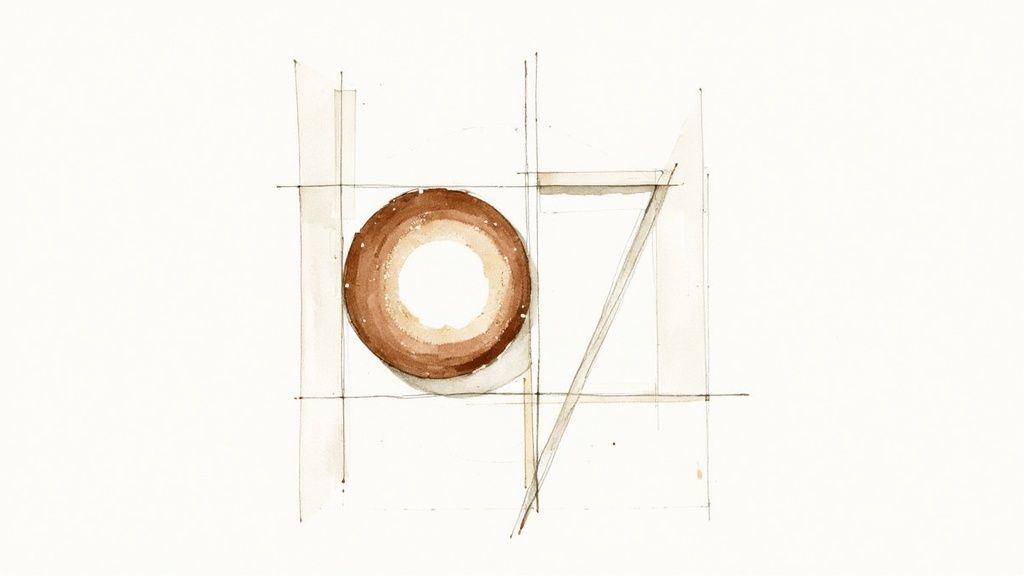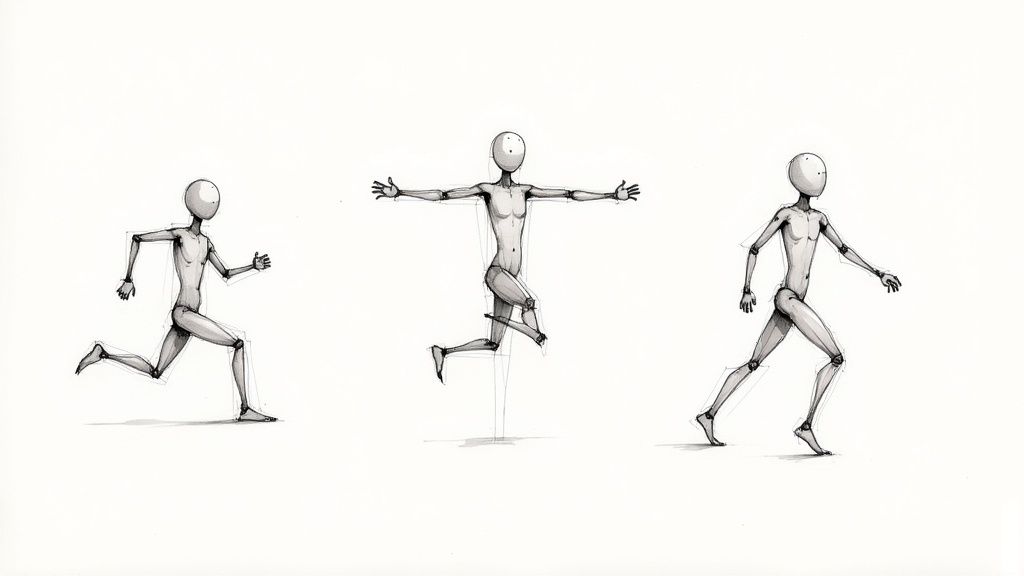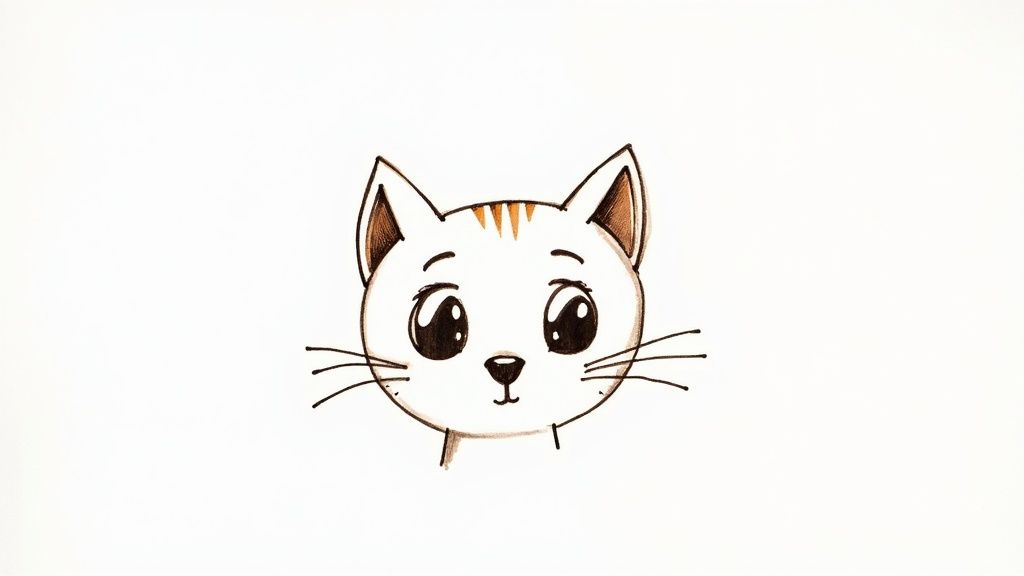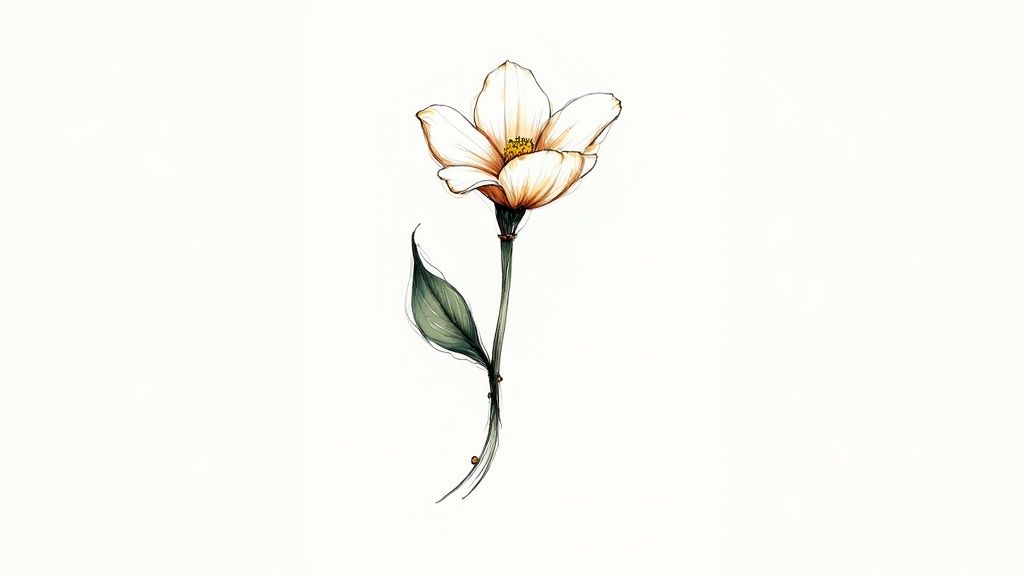The blank page can be intimidating, a canvas of endless possibilities that sometimes feels paralyzing. Many aspiring artists believe that creating beautiful art requires years of training and innate talent. But what if the journey begins with a single, simple line? This guide is designed to dismantle that creative block, offering a curated collection of drawing ideas easy enough for absolute beginners yet engaging enough for seasoned artists looking for a warm-up.
We will explore seven approachable categories that prove you do not need complex subjects to create compelling artwork. These prompts are your starting point, focusing on building foundational skills, boosting confidence, and, most importantly, making the creative process enjoyable. You will find actionable steps for everything from simple geometric shapes and cartoon animals to basic landscapes and cute food items.
This list is not just about what to draw; it is about how to start. Each category is structured to provide clear, simple sketch examples and brief descriptions that empower you to pick up a pencil and begin. Whether you want to fill a sketchbook, relax after a long day, or take the first step toward a new hobby, these ideas will get your pencil moving and your creativity flowing.
1. Simple Geometric Shapes
One of the most foundational and rewarding drawing ideas for beginners is to start with simple geometric shapes. This approach involves using basic forms like circles, squares, triangles, and rectangles as the core components of your artwork. By focusing on these fundamental building blocks, you can develop crucial skills such as hand-eye coordination, an understanding of form and structure, and a feel for composition without the pressure of creating a photorealistic masterpiece.

This method is incredibly versatile. You can create abstract art by arranging shapes in a visually pleasing pattern, or you can use them as the underlying skeleton for more complex subjects. Think of how a house can be broken down into a square and a triangle, or a human face can be mapped out with ovals and circles. This makes it an essential skill for artists of all levels.
Why This Idea Works So Well
Geometric shapes are a core part of many influential art movements. The Bauhaus school championed the use of simple forms in design, while artists like Piet Mondrian created iconic compositions using only rectangles and primary colors. Even complex Islamic geometric patterns are built from grids of circles and lines. This history demonstrates the power and sophistication that can be achieved with seemingly simple elements.
Actionable Tips for Drawing Geometric Shapes
To get started, try these practical steps. These techniques will help you move from basic practice to creating compelling compositions.
- Start with a Light Hand: Use light pencil strokes initially. This allows you to easily erase and adjust your composition as you go, building confidence without the fear of making permanent mistakes.
- Practice Freehand and with Tools: Begin with a ruler to get a feel for perfect lines and angles. Then, challenge yourself to draw the same shapes freehand to improve your muscle memory and line control.
- Experiment with Composition: Don't just draw one shape. Overlap them, vary their sizes, and arrange them in different ways. See how placing a large circle next to a small triangle changes the visual weight and focus of the drawing.
- Introduce Shading: Add simple shading to one side of your shapes. This small step instantly creates the illusion of three-dimensional form and adds depth to your work, transforming flat shapes into spheres, cubes, and pyramids.
2. Stick Figures and Basic People
Drawing the human form can seem intimidating, but starting with stick figures and basic people is one of the best drawing ideas easy enough for any skill level. This method strips figure drawing down to its essentials: lines and circles. By focusing on simple representations, you can learn the fundamentals of proportion, gesture, and movement without getting bogged down in complex anatomy.

This approach is powerful because it prioritizes communication over realism. A well-posed stick figure can convey more emotion and action than a stiff, anatomically perfect drawing. It’s the foundation for everything from quick gesture studies in art class to character animation and webcomics, making it a surprisingly versatile and essential skill.
Why This Idea Works So Well
The beauty of the stick figure lies in its simplicity and expressive potential. Webcomics like XKCD by Randall Munroe have built a massive following using stick figures to tell complex and humorous stories, proving that detailed art isn't necessary for effective communication. Animation pioneers like Walt Disney also used simplified skeletons to plan character movements before adding detail. This history shows that stick figures are not just a beginner's tool but a powerful device for visual storytelling.
Actionable Tips for Drawing Basic People
Use these practical steps to bring your simple figures to life. These techniques help you create dynamic and believable characters with minimal detail.
- Focus on the Line of Action: Before drawing limbs, sketch a single, curved line that represents the main flow of the pose. This "line of action" will give your figure a sense of energy and movement, preventing stiff, static characters.
- Use Basic Proportions: For a more realistic base, use a simple guide like the 8-head model, where the body is roughly eight head-lengths tall. You can simplify this by making the torso and legs each about three heads long.
- Convey Emotion Through Body Language: You don't need facial expressions to show emotion. A slouched posture can indicate sadness, while outstretched arms can convey joy or excitement. Experiment with how different poses change the character's mood.
- Use Simple Shapes for Volume: Once you are comfortable with lines, start adding simple ovals and cylinders over your stick skeleton. This will give your figures a sense of three-dimensional form and weight, making them more substantial.
3. Cartoon Animals
Drawing cartoon animals is a fantastic way to explore personality and expression without the pressure of strict anatomical accuracy. This idea focuses on creating simplified, stylized versions of animals by exaggerating key features to make them cute, funny, or emotive. By using basic shapes as a foundation, you can easily capture the essence of an animal while infusing it with a unique character, making this one of the most enjoyable and accessible drawing ideas easy for beginners.

This approach is all about creative freedom. Think of how Disney animators transform real animals into beloved characters like Mickey Mouse, or how Pokémon designs use simple forms to create hundreds of memorable creatures. The goal is not realism but recognition and emotion. A cat might become a series of circles with large, expressive eyes, and a bear could be simplified into soft, rounded rectangles and ovals.
Why This Idea Works So Well
The power of cartooning lies in its ability to communicate complex emotions and stories through simple, universal language. Icons of this style, like Walt Disney, revolutionized animation by focusing on appealing designs that connect with audiences on an emotional level. Similarly, the Japanese kawaii culture has made cuteness an art form, influencing everything from character design to branding. This history proves that you can create impactful and memorable art by focusing on expression over realism.
Actionable Tips for Drawing Cartoon Animals
To bring your own cartoon creatures to life, follow these practical steps. These methods help build a solid foundation for expressive character design.
- Start with Basic Shapes: Use circles, ovals, and rounded squares as the building blocks for your animal's body, head, and limbs. This simplifies the construction process and helps maintain appealing proportions.
- Exaggerate Key Features: Identify one or two distinctive traits of the animal and amplify them. For an owl, this could be huge eyes; for a rabbit, it might be long ears and big feet. This is the key to creating character.
- Study Real Animals Briefly: Look at photos or videos of the animal you want to draw. You don't need to memorize their anatomy, just observe their main shapes and how they move to capture their spirit.
- Practice Different Expressions: Once you have a basic character, draw it with different emotions. Experiment with simple changes to the eyes, eyebrows, and mouth to convey happiness, sadness, or surprise. To get more inspiration, you can find a variety of cartoon drawing ideas on drawinglist.com.
4. Simple Flowers and Plants
Drawing simple flowers and plants is a fantastic and relaxing way for beginners to explore organic shapes and natural beauty. This approach focuses on capturing the essence of botanical subjects using basic lines, curves, and simplified forms. By breaking down complex structures like petals, leaves, and stems into manageable components, you can create beautiful nature-inspired art without feeling overwhelmed by intricate details.

This idea is incredibly versatile and serves as an excellent entry point into botanical art. You can sketch a simple daisy using a central circle and radiating petals, or draw a stylized tulip with just a few graceful curves. These easy drawing ideas are perfect for decorating a journal, creating greeting cards, or simply practicing your observation skills and line work in a sketchbook.
Why This Idea Works So Well
Botanical illustration has a rich history, with artists like Maria Sibylla Merian pioneering the field by combining scientific observation with artistic skill. Today, this tradition continues through the nature journaling movement and art therapy, where drawing plants is used for both education and mindfulness. The inherent structure and symmetry in flowers make them naturally pleasing subjects that are both satisfying and easy to draw.
Actionable Tips for Drawing Flowers and Plants
To get started with botanical sketches, follow these practical steps. These techniques will help you capture the beauty of nature on paper. For a deeper dive into this subject, you can explore more drawing ideas for flowers on Drawinglist.com.
- Start with Simple Forms: Begin with flowers that have clear, simple shapes, like daisies, tulips, or poppies. Use a central circle for the flower's head and a simple curved line for the stem as your initial guide.
- Use Light Guidelines for Symmetry: Draw a faint vertical line through the center of your flower and horizontal lines to mark the top and bottom of the petals. This helps ensure your flower is balanced and symmetrical.
- Observe Real Flowers: If possible, look at a real flower or a high-quality photo. Notice how the petals overlap, how the leaves connect to the stem, and the subtle curves in its structure. This observation is key to making your drawings feel more authentic.
- Practice Different Petal Shapes: Experiment with drawing various petal shapes: long and thin, short and rounded, or pointed and jagged. This practice will build your visual library and allow you to draw a wider variety of plants.
- Add Simple Shading: Apply light shading at the base of the petals and along one side of the stem. This simple addition creates an illusion of depth and makes your two-dimensional drawing appear more three-dimensional and lifelike.
5. Basic Landscapes
Drawing a basic landscape is an excellent way to practice composition and perspective without getting overwhelmed by complex details. This idea focuses on capturing the essence of an outdoor scene using simplified elements like horizon lines, basic mountain shapes, simple trees, and fluffy clouds. By breaking nature down into its fundamental forms, you can create a convincing sense of space and atmosphere, making this one of the most rewarding and accessible drawing ideas easy for any artist to try.
This approach is incredibly versatile, allowing you to depict everything from a simple mountain and lake scene to a vast desert with cacti or a peaceful farm. The core skill you develop is arranging these simple elements in a way that creates depth and leads the viewer's eye through the scene. It's a foundational exercise that teaches the building blocks of all environment art. For more inspiration, you can find a variety of landscape drawing ideas on drawinglist.com.
Why This Idea Works So Well
The power of simplified landscapes has been embraced by artists for centuries. Traditional Chinese landscape painters used minimalistic brushstrokes to convey vast, spiritual environments. More recently, instructional artists like Bob Ross showed millions how to create "happy little trees" and majestic mountains with simple, repeatable techniques. The principles are also rooted in landscape photography composition, which uses leading lines and framing to create compelling images from natural elements.
Actionable Tips for Drawing Basic Landscapes
To start creating your own simple yet beautiful scenes, follow these practical steps. They will guide you in establishing a sense of place and depth in your work.
- Start with a Clear Horizon Line: This is the single most important line in your drawing. Place it high to emphasize the foreground or low to create a sense of a vast sky. This line immediately establishes the viewer's perspective.
- Use Overlapping Shapes to Show Depth: Draw objects in the foreground (like a large tree) partially in front of objects in the background (like mountains). This simple trick is a powerful and easy way to create a convincing illusion of three-dimensional space.
- Make Distant Objects Lighter and Less Detailed: This technique, known as atmospheric perspective, mimics how our eyes see the world. Use lighter pencil pressure and fewer details for mountains or trees that are far away to make them recede into the background.
- Practice Different Tree Shapes: Trees are not all the same. Experiment with simple silhouettes for different types, like the triangular shape of a pine tree or the rounded, cloud-like form of an oak. Arranging a few varied shapes makes a scene much more dynamic.
- Add Simple Textures: You don't need hyperrealism. Use simple squiggly lines for grass, parallel lines for wood grain on a barn, or stippling (dots) for a sandy texture. A little bit of texture goes a long way in adding interest.
6. Cute Food Items
One of the most delightful and popular drawing ideas easy for beginners is creating cute food items. This style, often called kawaii art, involves giving everyday foods like cupcakes, sushi, or fruit anthropomorphic features such as expressive faces and charming, simplified forms. By merging recognizable food shapes with adorable aesthetics, you can create universally appealing artwork that brings a smile to anyone's face.
This idea is incredibly beginner-friendly because it leverages simple shapes you already know. A piece of sushi is a rectangle, an orange is a circle, and a slice of pizza is a triangle. Adding a couple of dots for eyes and a curved line for a smile instantly transforms these basic forms into lovable characters. It's a fantastic way to practice character design and conveying emotion with minimal detail.
Why This Idea Works So Well
The global appeal of cute food art is rooted in Japanese kawaii culture, which celebrates all things adorable. Artists like Claire Belton, the creator of Pusheen, have popularized this style, showing how simple illustrations of a cat enjoying a donut or a cookie can become a cultural phenomenon. Even the emoji set on your phone is filled with examples, from a smiling avocado to a happy-faced takeout box, proving the power and reach of this approach.
Actionable Tips for Drawing Cute Food Items
To start bringing your food illustrations to life, follow these simple and effective steps. These tips will help you master the key elements of the kawaii style.
- Start with Simple Food Shapes: Begin with foods that have a clear, basic geometric form. A round donut, a triangular slice of watermelon, or a rectangular juice box are perfect starting points. Focus on getting the core shape right before adding any details.
- Add Simple Dot Eyes and Curved Mouths: The classic kawaii face is incredibly easy to draw. Use two simple dots for eyes, placed relatively far apart, and a small, curved "u" shape for the mouth. This simple combination is highly effective at creating a happy expression.
- Use Blush Marks for Extra Cuteness: To enhance the adorable factor, add small ovals or a few short lines on the "cheeks" of your food character, just below the eyes. This simple detail instantly makes the character look more charming and bashful.
- Experiment with Different Expressions: While a simple smile is a great start, don't be afraid to try other emotions. You can create a surprised look with wide-open circular eyes or a sleepy expression with downward-curving lines. This is excellent practice for learning to convey feelings through your art.
7. Simple Patterns and Mandalas
Diving into the world of simple patterns and mandalas is a fantastic way to create visually stunning art through repetition and symmetry. This drawing idea focuses on building intricate designs from simple, repeated marks, lines, and shapes. Mandalas, which are circular, symmetrical designs, are particularly rewarding as they guide you through a meditative process of creation, starting from a central point and expanding outward.
This approach is one of the most accessible drawing ideas easy for anyone to try because it doesn't rely on realistic depiction. Instead, it emphasizes rhythm, balance, and focus. You can create everything from simple doodle patterns that fill a page to complex, geometrically precise mandalas. The act of drawing repetitive shapes is often described as calming, making it a perfect activity for relaxation and mindfulness.
Why This Idea Works So Well
The power of patterns is rooted in both ancient spiritual traditions and modern therapeutic practices. Traditional Buddhist and Hindu artists have created sand mandalas for centuries as a form of spiritual practice and meditation. More recently, the Zentangle Method, developed by Rick Roberts and Maria Thomas, popularized structured patterns as a way to promote focus and creativity. The rise of the adult coloring book movement further cemented the appeal of these intricate, satisfying designs.
Actionable Tips for Drawing Patterns and Mandalas
Getting started with patterns is straightforward with these practical tips. They will help you build beautiful, balanced compositions.
- Start with a Central Point: For mandalas, always begin with a dot in the center of your page. Use a compass to draw concentric circles and a ruler to create guide lines radiating from the center, like spokes on a wheel. This creates a foundational grid for a symmetrical design.
- Practice Basic Patterns First: Before tackling a full mandala, fill a sketchbook page with simple repeating patterns. Try drawing rows of scallops, cross-hatching, simple leaves, or spirals. This builds your muscle memory for the small, consistent marks required.
- Build in Layers: Don't try to draw the entire intricate design at once. Work outward from the center, completing one ring or section at a time. This makes the process less intimidating and allows the pattern to grow organically.
- Embrace Imperfection: Especially when starting, your lines might not be perfectly even, and your symmetry might be slightly off. This is part of the charm of a hand-drawn piece. Focus on the process rather than a flawless outcome.
7 Easy Drawing Ideas Comparison Guide
Item | Implementation Complexity | Resource Requirements | Expected Outcomes | Ideal Use Cases | Key Advantages |
|---|---|---|---|---|---|
Simple Geometric Shapes | Low | Minimal (pencil, paper, ruler) | Fundamental drawing skills, muscle memory | Beginners learning form and shape | Builds confidence, versatile foundations |
Stick Figures and Basic People | Low | Minimal (pencil, paper) | Basic human proportion, gesture understanding | Storytelling, comics, quick sketches | Fast execution, focuses on movement |
Cartoon Animals | Moderate | Basic to moderate (optional colors) | Expressive, cute characters, personality | Children's books, animation | Fun, forgiving of anatomy errors |
Simple Flowers and Plants | Moderate | Basic (pencil, paper, references) | Observation of natural forms, organic curves | Nature journals, decorative art | Relaxing, abundant references |
Basic Landscapes | Moderate | Basic (pencil, paper) | Spatial awareness, composition, basic perspective | Outdoor scenes, art practice | Teaches composition, satisfying results |
Cute Food Items | Low | Minimal (pencil, paper, optional colors) | Charming, approachable character designs | Social media, stickers, character design | Popular style, appeals to wide audience |
Simple Patterns and Mandalas | Moderate to High | Basic to moderate (ruler, compass) | Precision, symmetry, meditative focus | Stress relief, detailed art | Develops patience, stunning visual effects |
From Blank Page to Full Sketchbook: Your Next Steps
You've just explored a treasure trove of simple yet powerful drawing prompts, from the foundational elegance of geometric shapes to the whimsical charm of cartoon foods. The journey from a daunting blank page to a filled sketchbook is paved with these exact types of accessible and engaging exercises. This collection of drawing ideas easy to master is more than just a list; it's a foundational toolkit designed to build both your skill and your confidence.
Remember that the core of all complex art lies in these simple beginnings. A detailed portrait starts with basic ovals and lines, just like the stick figures you practiced. A lush, photorealistic botanical illustration has its roots in the simple flower shapes you sketched. By consistently engaging with these fundamentals, you are not just doodling; you are training your hand, sharpening your eye, and developing a deep, intuitive understanding of form, line, and composition.
Key Takeaways for Your Artistic Journey
The most significant barrier to drawing is often not a lack of talent, but a lack of direction. By focusing on these categories, you've learned to bypass that initial hesitation.
- Embrace the Building Blocks: Every object can be deconstructed into simple shapes. Continue to see the world this way, identifying the circles, squares, and triangles that form the objects around you. This is a powerful observational skill.
- Consistency Over Complexity: Drawing for ten minutes every day with these simple ideas will yield more progress than struggling for two hours once a month on a complex piece. The goal is to make drawing a regular, enjoyable habit.
- Imperfection is a Feature, Not a Bug: Your early sketches are not meant to be masterpieces. They are practice. Each crooked line or lopsided circle is a valuable piece of data that informs your next attempt. Celebrate these "mistakes" as evidence of your effort and learning.
Your Actionable Next Steps
To truly solidify your skills and continue your growth, it’s time to put these concepts into action with a clear plan.
- The "One-a-Day" Challenge: Dedicate the next week to drawing one item from each of the seven categories. On Monday, draw a geometric pattern. On Tuesday, a stick figure in motion. By Sunday, you'll have a diverse collection of new sketches and a reinforced sense of accomplishment.
- Combine and Create: Now that you have a handle on individual subjects, start combining them. Draw a cartoon animal holding a cute food item, or place simple flowers in front of a basic landscape. This is how you begin to create unique scenes and develop your own style.
- Refine a Favorite: Go back through your sketches. Which category did you enjoy the most? Pick one of your favorite drawing ideas easy to execute, like a simple rose or a cartoon cat, and draw it ten more times. Experiment with different angles, expressions, and details to see how you can evolve a simple concept.
The value of mastering these easy drawing ideas extends far beyond the sketchbook. It’s a meditative practice that enhances mindfulness, a creative outlet that reduces stress, and a powerful method for improving your problem-solving skills. You are learning to see the world with an artist's eye, finding beauty and structure in the everyday. Keep this momentum going, and let your curiosity guide you. Your sketchbook is waiting.
Ready for a never-ending supply of inspiration? The Drawing List Ideas Generator provides thousands of unique prompts tailored to your skill level, ensuring you always have fresh drawing ideas easy to access. Visit Drawing List to generate your next idea in seconds and keep your creative journey moving forward.